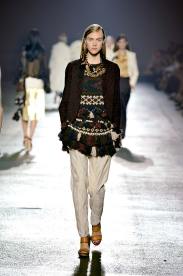Dries Van Noten’s vivid imagination knows no bounds, resulting in collections that are kaleidoscopic in their references. On the eve of a new exhibition of his work in Paris, Tamsin Blanchard is granted a glimpse into his world.
[dropcap size=small]T[/dropcap]here is a corner of Antwerp that belongs to Dries Van Noten. His shop, Het Modepaleis, with its original 1881 sign’s gold art nouveau script lovingly restored, sits on the corner of Nationalestraat, a busy street filled with trams and cars. The distinctive triangular five-storey building (a bit like the Flatiron building in miniature) has all the grandeur of a small department store.
When it came up for sale in 1989 Van Noten, who had launched his label in 1986, decided to buy it. It was an audacious move for a fledgling fashion company, yet the shop is now a landmark, the designer’s indelible stamp on the city.
But when I visited recently the shop was closed, empty apart from the last few boxes of autumn/winter stock being packed up ready to be replaced with the new collection for spring/summer. “Here in Antwerp we have a tradition that we do sales and then we clean up the store,” Van Noten told me. “We put the new stuff in and then we open up with the new collection.” It is apparently busier than the first day of the sales, with die-hard fans queuing to be sure to get the particular pieces they want.
There is something charmingly old-fashioned about this tradition. There are very few fashion houses that would shut up shop for a week to give it a lick of paint and change from one season to the next. But Van Noten likes to do things his own way, running his business entirely independently. He has two more standalone shops in Paris and more than 500 stockists worldwide, and his annual turnover is estimated to be about 55 million euros. His core business is still clothing, which makes up more than 90 per cent of his output (in contrast to the big luxury fashion houses, which focus their sales on bags and shoes). Van Noten takes his collections to Paris four times a year (twice for women and twice for men), working with the show producer Etienne Russo, who started out as a house model in the 1980s. Van Noten asked Russo to help with his first men’s show in 1991, and Russo went on to set up his own show-production company and now works with Lanvin, Hermès and Chanel.
The Dries Van Noten headquarters are in an impressive 43,000 sq ft warehouse he bought in 2000. “In Paris or London, this building wouldn’t be possible,” Van Noten said. “We are independent and we are successful, but I don’t have the financial power of the big groups.”
I met Van Noten at the end of January. It was just over a week after his men’s show in Paris for autumn/winter 2014, and a month before his next women’s show and the opening of the first major exhibition of his work, on March 1. Dries Van Noten – Inspirations will occupy two floors of Les Arts Décoratifs, next to the Louvre, in Paris. It will display Van Noten’s work beside relevant clothes from the museum’s archive as well as paintings, film, and art and photography from Van Noten’s own eclectic collections.
Van Noten’s red-brick warehouse overlooks the grey water of Willem Dock. His office is at the front of the building, on the fourth floor – a raw industrial space with bare brick walls and a large desk, which he told me came from the boardroom of a leading Belgian brick manufacturer. The tall cupboards behind the desk were salvaged from the city’s Court of Justice. They were designed to hold barristers’ robes. Van Noten bought the court’s entire contents to furnish his headquarters; the oversized cabinets and dark wood furniture give the cavernous space the atmosphere of an old clerk’s office.
Van Noten was dressed conservatively, in a navy jumper and khaki trousers, with a checked scarf tied around his neck as though he was feeling the cold. His grey-brown hair was neatly cropped. He poured us each a glass of water and we sat at the smaller worktable in front of the boardroom desk. Next to us was a long strip of black fabric keeping the swatches for his next collection tantalisingly hidden from view.
Harry, the handsome five-year-old Airedale owned by Van Noten and his long-term partner in life and business, Patrick Vangheluwe (who joined the company as Van Noten’s right-hand man in 1987), was lolling in his basket. Harry occasionally gave a bit of a howl when he wanted some attention, and at one point Van Noten held a napkin around his chin as he noisily lapped up water from his bowl. “He has a beard, and if I didn’t do this he would clean it on somebody’s pants,” he said.
“The exhibition is a bit scary,” Van Noten said when I asked him about his preparations for the upcoming event. “It’s not an identity crisis, but you start to question yourself. Is my work worthy of being shown in a museum? Do we have enough pieces to show? But also you go back to things you did 20 or 25 years ago and try to analyse why you did certain things, why you made certain decisions.”
His early archives are sketchy; they don’t really start until 1994. Before that clothes were too precious a commodity to hang around in the studio. “At that time every garment represented money, and as a young company we needed money, so of course we paid models with clothes and we sold as much as we could,” he said. He managed to get his hands on two pieces from his final degree collection in 1981 when his sister-in-law came upon them while moving house… Read more in Quintessentially Asia.




















